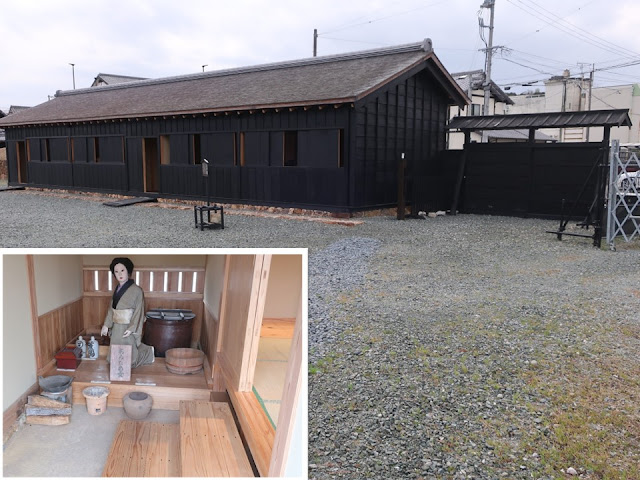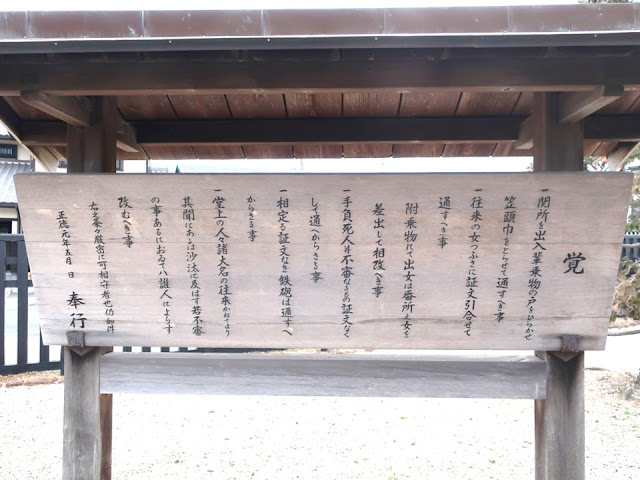The building was built in 1858 and was used as the checkpoint; it is the sole checkpoint which was actually used in the Edo period (1603~1868). In 1869, all checkpoints were abolished by the new government which defeated the Edo Bakufu (shogunate). Thereafter the building had been used as an elementally school or a public office. I really thanks to the people who didn’t demolish it. Btw, the museum in the site shows us how people wanted to travel, but every private visitor cannot take photos of exhibits, sorry to say.
関所の建物は1858年に再建されたもので、日本で唯一の現存建物です。1869(明治2)年に関所制度が廃止された後は、小学校や役場として使われました。よく残ってくれたものです。史料館(個人は展示品の撮影禁止)では、旅への欲求が伝わってきました。
The checkpoint on the left and the museum on the right.
左が江戸時代から残る新居関所の面番所、右が史料館です。
The building was at the side of Hamana-ko (lake), so travelers from the east came by boat.
江戸時代の新居関所は、浜名湖の湖畔にあり、東からの旅人は舟でやって来ました。
Travelers walked to the checkpoint from the pier above.
渡船で着いた旅人は、ここから面番所へ向かいました。
Travelers from the west walked through the gate (the gate above was rebuilt) and went to the checkpoint.
陸路・東海道(京側)からは、大御門(復元)を通って面番所へ向かいました。
Around forty staff checked travelers.
通行人を改める面番所。関所では約40人の役人が務めていました。簡易な駕籠のような物が置いてあります(左下)。
The staff (doll) in front is the lowest class of samurai. He seems to be shallow.
手前は、番所足軽。ちょっと軽い感じですね。
The head of the staff sits down innermost. They checked a passport and so on.
一番奥には番頭が座っています。
Two female staff and their families lived the rebuilt tenement above. They were wives or mothers of the lowest class of samurai. Men could pass the checkpoint if they had a passport. However, women had to submit her passport at each checkpoint. Women traveled under the severe regulation. It is said that the shogunate prevented wives of daimyo lords from escaping; they were forced to live in Edo (old name of Tokyo), so they were hostages in fact.
女改め之長屋(復元)には、二人の改め女とその家族が住んでいました。改め女は関所足軽の妻や母が務め、仕事は面番所で行っていました。男性は往来手形を持っていれば関所を通過できましたが、女性は関所毎に女手形と提出しました。チェックが厳しいです。
The regulation of the checkpoint in 1711 is posted. Women, injured dead people and guns never permitted to go through the checkpoint without passport. The passport was issued not only to ordinary people but also to a madness, a prisoner, a head of a dead person in order to pass the checkpoint.
In the case of breaking through the barrier, the man was sentenced to crucifixion. A woman who accompanied the man became a slave. Someone hired the women. Or she was imprisoned if no one applied. The rule was gradually eased.
It was written on a passport “Please bury following a local practice if I died” and so on.
関所の改めのルールが書かれています。女性、手負死人、鉄砲の通行には証文が絶対必要とのことです。手形の種類として、女、乱心、囚人、首、死骸、鉄砲等がありました。いろいろな人や物が関所を通過していったのですねえ。
関所破りは、厳罰で、男は磔(はりつけ)、男に連れられて関所を破った女は奴(やっこ、身柄を所望に与える。所望者がなければ牢舎に収監)でした。その一方で、関所の取り調べは、次第に緩和されていきました。
旅人の往来手形には、旅の途中で死亡したときは、その土地の作法で処分してくれ、などと書かれていました。
In the museum, the history and the role of the checkpoint are shown at the first floor.
さて、史料館(展示品撮影)。一階は、新居関所の変遷や役割が展示されています。
On the second floor, various old gadgets for trip are exhibited. The photo above is from the brochure of the museum, and the banner at upper left was provided by the museum.
The banner (600mm/wide×1850mm/long) says “Okage (Thanks to Ise Shrine)”. It means people without a passport went to Ise Shrine with the banner. I felt their passion.
There are magnetic exhibits such as a foldable lunchbox and a sword shape coin holder. On the other hand, a lunch box for picnic and a water bottle (both of them are lacquered) show me the leeway of the predecessors. They enjoyed their life. It’s worth visiting.
二階の展示室には、様々な旅の道具が展示されていました(上の写真はいただいたリーフレットのものです)。
目を惹かれたのは、赤地に黒で「お可げ(おかげ)」と書かれたお陰参りの幟旗。幅が60cm、長さは185cmもあります。手形を持った本参りではなく、抜け参りであるお陰参りで、堂々と幟を立てて伊勢に向かったとは、庶民のパワーを感じます。(左上の写真は、史料館様から提供していただきました)
また、折りたたみ式の小さな弁当箱、道中差し(短刀)の形をした銭入れなど珍しい物も展示されていました。一方、野弁当箱と水筒は漆塗りのよい品でピクニックを楽しむ余裕を感じさせてくれました。見応えのある展示でした。
Visited in March, 2023
Official
website: https://www.city.kosai.shizuoka.jp/kanko_bunka_sports/kankospot/9675.html
(in Japanese), accessed in September, 2023
Previous post (museum in the same prefecture): Kakegawa castle and
Toukaidou-highway、掛川城と東海道
Next post (old houses near the ex-checkpoint): Komatsu-rou and Kinokuniya in Arai post-town、新居宿小松楼・紀伊国屋












Comments
Post a Comment